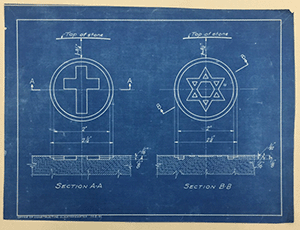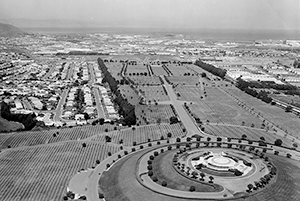Facts: NCA History and Development (2 of 3)
2. Transformations Between World Wars
More than 116,000 service members died during World War I (1914–1918). But the efficiency of the War Department's Graves Registration Service combined with new identification "dog tags" vastly reduced the number of unknown burials to 3.5 percent. World War I also marked a major advance in burial eligibility and memorial products in national cemeteries.
Legislation enacted in April 1920, ensured that anyone who served in any war in which "the United States has been or hereafter be engaged" and U.S. citizens who "served in the Army or Navy of any government at war with Germany or Austria" during World War I who died in service or are honorably discharged, may be buried in any national cemetery.
To honor the sacrifice and scale of World War I, government officials created a larger, new marble upright headstone to distinguish these Veterans from service in nineteenth-century conflicts. Notably, it features an optional "emblem of belief" — initially a Latin cross for Christian faith and Star of David for Jewish faith. This "General" upright headstone was produced beginning in the 1920s and it has been in continuous use for all conflicts since, though the number of emblems and inscription elements has changed.
 Blueprint of new marble upright headstone with optional "emblem of belief" feature.
Blueprint of new marble upright headstone with optional "emblem of belief" feature.As Army officials were creating the General headstone for domestic graves, plans were underway to honor the American Expeditionary Forces who were buried abroad in a new kind of cemetery. On March 4, 1923, Congress created the American Battle Monuments Commission (ABMC) to oversee these military cemeteries and monuments. The Army operated eight World War I cemeteries in Europe until 1934 when they were transferred to ABMC; subsequently, fourteen World War II cemeteries in Europe, Africa, and the Philippines would become part of ABMC. Akin to emblems of belief, ABMC graves are marked with marble headstones in the form of a Latin cross or Star of David.
The third decade of the twentieth century saw major changes regarding national cemeteries: development of new ones where the largest populations of Veterans lived, reassignment of federal responsibility, and the introduction of flat markers. And, setting the stage for later consolidation, Congress in 1930 established the Veteran's Administration (VA) which assumed responsibility for NHDVS and their cemeteries.
Until the early 1930s, national cemeteries were operated by the Army. In the first major system expansion since the Civil War, even as World War II loomed, it planned seven new cemeteries for the Veterans of past conflicts.
For the first time, national demographic data determined the placement of "inter world war" cemeteries, 1934–1939, in or near urban centers. Some encompassed existing cemeteries. All were much larger than predecessors with building complexes designed to reflect regional or "federal" architecture. Some construction was supported by President Franklin D. Roosevelt's New Deal programs, including the Works Progress Administration.
 Golden Gate National Cemetery was established in 1938 and the first interment took place in 1941.
Golden Gate National Cemetery was established in 1938 and the first interment took place in 1941.While the Army was providing new burial space for current generations of Veterans, the number of cemeteries it oversaw decreased. Some of the most significant battle-related Civil War cemeteries were transferred to the U.S. Department of the Interior, National Park Service, for interpretation and historic preservation. NPS manages fourteen national cemeteries today; only Andersonville National Cemetery, Georgia, is open for burials.
Until the 1930s, the Federal government only provided upright marble headstones for Veterans' graves. Between 1936 and 1940 flat markers produced in marble, granite, and bronze were introduced. These unobtrusive rectangular markers were key elements of suburban Memorial Park-style (1917–present) cemeteries. Initially produced for private cemeteries that did not allow uprights, they were first used in national cemeteries built by the Army after World War II, notably in Hawaii and Puerto Rico. Nine national cemeteries use flats exclusively and seventy-eight use them along with separate sections using upright headstones.
After the Army opened a few final post-World War II properties it maintained a non-expansion cemetery policy until the 1960s. This was also the last era of cemeteries with housing for superintendents, who were no longer required to live on site. On March 18, 1968, a report initiated by President Lyndon Johnson to evaluate all Veteran programs was submitted to Congress. As a result of these findings, the National Cemeteries Act of 1973 (PL 93-43) was signed into law in June 18, 1973. Foremost, it transferred 82 national cemeteries from the Army to VA. The Army retained responsibility for Arlington National Cemetery and Soldiers' & Sailor's Home National Cemetery in Washington, D.C.

















